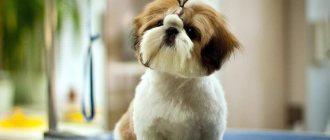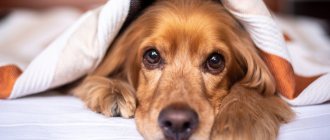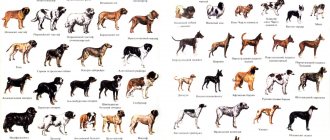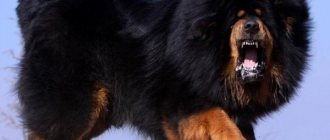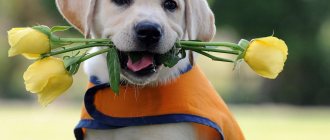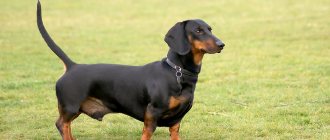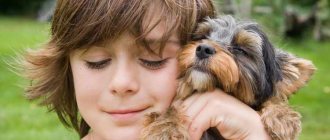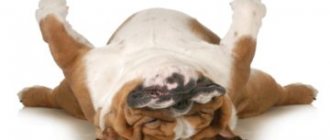The four-legged pet is a sincere, faithful and devoted animal. It’s hard to disagree with this opinion. The dog barks, sensing danger next to its owner, wags its tail when it sees him after a long separation. Hundreds of years ago it became fashionable to present purebred puppies as gifts to royalty and government officials. Today, furry pets remain one of the preferred pets of many families. The article presents the most popular dog breeds in Russia and the World.
Criteria for evaluation
Fashion for four-legged animals changes as quickly as fashion for clothing. But when choosing an animal, a person is not always guided by the latest trends in the pet industry. The dog will live next to its owner for 10-15 years, which means that the decision should be taken responsibly and judiciously.
Dog size
It is unwise to own popular breeds, German Shepherds or Dobermans, in a city apartment. This will cause inconvenience to the owner and his family. A large animal will feel cramped and stuffy. Sedentary short walks within the metropolis will have a detrimental effect on his health. Spacious local areas of a country cottage, with wide outdoor enclosures, are an ideal option for such large breeds of dogs. They will be able to perform their essential security job functions.
The popular breeds Yorkies and Dachshunds, on the contrary, will like a small lounger in the corner of the room. Many dwarf dogs do not require daily walks and relieve themselves in the home litter box.
Attitude towards children
Psychologists have developed a whole program of wishes for the cohabitation of a child and a dog. Based on this, a family with a child under six months old is generally not recommended to have a dog of any breed. As they get older, Pinschers, Italian Greyhounds, American Terriers and others are allowed.
It is strictly forbidden for families with children of any age to have pit bulls, wolfhounds, or boxers.
Owner's physical health
Some popular breeds are hyperactive. This applies to terriers and chihuahuas. Little dogs will turn the house upside down if the owner does not walk them outside. They prefer active games. Quiet sitting on the couch is not suitable for these four-legged animals.
Dog experts do not recommend that older people own fighting breeds of dogs. A young, strong man can cope with a heavy animal. When he sees a cat on the street, the dog may instinctively rush after her. To hold, for example, a Rottweiler, you need good physical strength.
Owner's financial capabilities
Some miniature dog breeds require significant investments in care and maintenance. One of these is the French Bichon Frize. An owner with an average income should refuse such a purchase.
Shepherds and bulldogs are economical animals to keep.
Allergy
A popular disease among Russians in recent decades. But this is not a reason to refuse the long-awaited purchase of a pet. The main thing is to take into account all the characteristics of the dog. Breeders have developed a large number of hypoallergenic breeds. They do not shed and do not have a specific smell. Due to this, they do not cause a reaction in humans.
The history of the appearance of different breeds of dogs
If we turn to antiquity, we can identify the main ancestor of all today's dog breeds - the wolf. Scientists have different opinions about the time of domestication of the wolf; according to various sources, this happened from 15,000 to 50,000 years ago. The reasons for the predator's attachment to human groups are not clear. One version says that nomadic peoples used wolves for hunting and personal needs (the meat of tamed wolves was eaten, and clothes were made from the skins). Another version is that wild animals themselves sought food from ancient people. Allegedly weakened and expelled from the pack, individuals independently joined human settlements and were used for the same hunting and home protection. The remains of dogs have been found on all continents without exception, their images are immortalized on ancient bas-reliefs and paintings, which indicates the long-standing popularity of these animals.
Boar hunting scene with a dog, ancient Roman sculpture
The oldest dog breeds
formed on Earth at a time when no one knew about selection. These are individuals (aboriginal or primitive) whose DNA is closest to wolves - Akita and Shiba Inu, Alaskan Malamutes, Siberian Huskies, Shar Pei and others. Over time, in addition to native dogs, factory dogs began to appear - bred as a result of crossing animals of various primitive breeds. The formation of most factory breeds was based on inbreeding - intrageneric crossing of aboriginal individuals, as well as the identification and elimination of its undesirable consequences (aggressive or timid character, abnormal body structure, unattractive exterior). Dog selection reached its heyday in the 19th – 20th centuries, when most dog breeds were bred and approved by cynological organizations.
Global popularity in 2021
There is no general criterion by which a dog can be classified as a preferred breed. Every fifth person gained worldwide popularity due to their appearance, character traits and work qualities.
The owner chooses a pet for himself, which means both must have the same character. Otherwise they will not be able to get along together.
The list of the most famous and popular dog breeds opens with ancient burrowing four-legged animals.
Dachshund
“Limousine Dog” is a friend and companion to the owner. This is a cheerful, kind animal with an independent character, medium size with short legs. Suitable for those people who prefer an active lifestyle.
The dog barks loudly and a lot. Before acquiring one, the owner needs to evaluate all the pros and cons of this breed, widespread in the world. It is not recommended to have a dachshund in a family with children. Hyperactivity and mobility of the animal can harm the baby.
Keeping a dog does not require large investments and time. The smooth-haired dachshund is suitable for people suffering from mild allergies. She is comfortable both in a rural house and in a city apartment. Due to its small dimensions, such a dog will require little space.
Types of dog breeds
According to the rules of the International Canine Organization, dog breeds can be divided into groups as follows:
- Guard dogs - their activity is aimed at protecting the owner’s property. Sensing danger, guard dogs warn the owner with a loud bark, at the same time scaring away possible ill-wishers. However, the tasks of such animals do not include attacking a potential enemy (this is their main difference from guard dogs). Most often, quite large pets are kept as guards, capable of scaring off someone who encroaches on someone else's property with just one look. This group includes German and Caucasian shepherds, Moscow watchdogs, and Rottweilers.
- Guard dogs - their advantage is a quiet and unexpected attack on a stranger who has come with malicious intent to the owner’s territory. Unlike guard dogs, which bark loudly when there is possible danger, guard dogs act silently. At the command of the owner, the dog is obliged to release the “prey”, under no circumstances starting a bloody fight. Guard dogs - Doberman Pinschers, Staffordshire Terriers, Cane Corsos, most shepherd dogs can also be perfectly trained to protect the owner's property.
- Hunting dogs - this group includes pointers (Hungarian Vizslas, setters, Weimar pointers), greyhounds (Russian greyhound, Hortai, Afghan hound and others), hounds (Russian piebald, Estonian, Anglo-Russian hounds), retrievers (Labrador, Golden, Curley Retrievers), Spaniels (American and English Cocker Spaniels, Sussex and Welsh Springer Spaniels), Dachshunds, Terriers (Jagdterrier, Fox Terrier, Jack Russell Terrier and other breeds), Spitz and Laikas - they are classified as one group (Yakut Laikas, Karelian Bear Dogs, Finnish Spitz and others are known).
- Herding dogs are created to help in the peasant farm. Their task is to herd the herd, protect trusted livestock from predators, and drive away ill-wishers from the owner’s home. Many shepherd dogs in urban environments gradually became companion dogs due to their stable nervous system, amiability and loyalty, as well as service dogs and even guard dogs (such as the German Shepherd). Herding dogs - collies, moodies, Croatian, Portuguese, Romanian shepherds.
- Indoor decorative dogs - these animals are small in size, rather slender and weak to perform any mission other than entertaining and accompanying the owner. These dogs include the following breeds: Japanese Chin, Toy Spaniel, Chinese Crested.
- Companion dogs - these animals have become human companions in urban environments. They can live not only in an apartment, but also in an outdoor enclosure. However, all companions need long-term communication with the owner, games, and walks. These dog breeds can be of different sizes, but they are usually distinguished by their good character, gentleness, and obedience. Poodles, pugs, and beagles can be considered companion dogs, although most breeds, with proper upbringing, can become true friends of modern man.
What to look for when choosing a puppy
Before purchasing a puppy, the future owner needs to clearly decide on the desired breed and the purpose of getting a dog. It is advisable to study the characteristics of the breeds so as not to get into trouble. The fact is that, through the long efforts of scientists, some breeds initially have a dominant function, aggression, for example, towards animals, wariness and distrust towards humans. Other dog breeds, on the contrary, are distinguished by their soft and cheerful character, and the ability to get along with both people and animals. Therefore, the owner, first of all, needs to focus on his own needs and the character of the future dog, and not on the appearance of the animal. So, before buying a dog you need to:
- Decide not only on the breed, but also on the size of the pet.
A small living space is unlikely to allow keeping large breed dogs (mastiffs, Great Danes, etc.). In addition, many four-legged animals need physical activity, which is usually only possible when living in private or country houses with fenced areas.
- Understand whether it is possible to care for a dog that sheds heavily or has long hair.
If the dog owner has little time, then having a pet that requires daily care is quite unreasonable - both the pet and the entire apartment, covered with a layer of fur, will look untidy.
- Determine the age of the animal
– puppies are usually purchased at the age of 2 months. In this case, you can shape the dog’s character according to your own desire, while adult dogs, firstly, will have a more difficult time adapting to a new home, and secondly, will have habits instilled by a stranger (the breeder).
- Select the gender of the dog.
Typically, females are more good-natured and calmer than males. While males are more active, without proper education they can provoke fights with other animals - both at home and on a walk.
- Find out where exactly you plan to buy a puppy
– at the poultry market, via the Internet, in a breeding nursery. The prices of dogs from the kennel seem high, but this is where you can buy a healthy and vaccinated animal with documents, born from dogs without genetic diseases.
- Before buying a puppy, you should make sure its health
– look at the condition of the teeth, eyes, ears, palpate the belly, paws, examine the fur, and also be sure to ask the seller (especially when the animal is purchased at the market) about the dog’s parents, its character, and nutrition.
Whatever breed of puppy is chosen, the owner must always be clearly aware of his responsibility, which consists of: good care (walking, bathing, combing, hygiene procedures), high-quality nutrition (natural food or ready-made industrial food), daily communication with the dog (including games, education and training), in regular preventive examinations at the veterinarian, in organizing the dog’s place (a home bed in a quiet and calm corner, an outdoor enclosure with an insulated booth), in one’s own capabilities - a dog always requires a lot of time, she can be naughty and even act contrary to the owner, be disobedient at first. However, the owner’s reaction can be moderately strict; under no circumstances should you hit the dog or yell at it.


